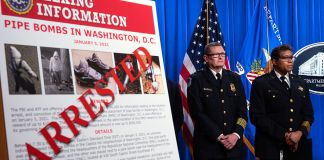A wildfire that has closed the North Rim of Grand Canyon National Park raged out of control over the weekend and is now the largest currently burning in the country. The Dragon Bravo fire has burned more than 123,000 acres and was only 13 percent contained as of Monday afternoon, according to a federal interagency website that tracks wildfires.
The blaze, which was sparked by a lightning strike on July 4, has destroyed about 70 structures, according to the National Park Service, including the historic Grand Canyon Lodge and North Rim Visitor Center. The damage was bad enough to prompt the service to close the North Rim of the park for the rest of the 2025 season.
Thirty-nine large wildfires are burning across the country, covering about 523,000 acres in total, according to the National Interagency Fire Center. Dry and windy conditions pushed the Grand Canyon fire out of control last month, and it is now one of seven large fires burning across Arizona, more than in any other state.
The fires come as the National Park Service and other federal agencies face large cuts to their workforces, including among personnel who help fight wildfires. Multiple reports have suggested that cuts made by the Trump administration to U.S. Forest Service staffing have hampered the agency’s ability to fight fires.
The National Park Service has lost 24 percent of its permanent workforce under the Trump administration, according to an analysis last month by the National Parks Conservation Association. The group said the cuts have reduced visitor services and weakened wildfire response.
A Park Service spokesperson said in an email that the agency’s priority has been the safety of firefighters, staff and the public, and that it had successfully evacuated about 900 people from the North Rim area. The spokesperson added that “extreme weather conditions and a shift in wind overwhelmed” the service’s efforts to contain the Dragon Bravo fire and that “these rapidly evolving conditions were the primary cause of the fire’s expansion.”
A White House spokesperson noted that no one has died in the fire, saying that outcome “is a direct reflection of coordinated evacuation efforts, interagency support, and proactive incident management before and during the fire’s rapid expansion.”
The spokesperson added: “It’s a shame that there are those who want to politicize this situation while firefighters are still putting their lives on the line,” and said that more than 7,200 Interior Department employees were qualified to respond to wildfires, about 800 more than in 2024.
Bill Wade, executive director of the Association of National Park Rangers, which supports park service staff, said he had not heard anything to suggest that staff shortages played a role in allowing the Dragon Bravo fire to grow out of control. But he said he is concerned the cuts could harm the service’s ability to respond to fires in the future.
Wildfires have closed parts of other national parks, too, including Black Canyon of the Gunnison in Colorado.
Climate change is worsening wildfire activity globally. Wildfire seasons have grown longer, and the smoke and climate pollution that fires emit is getting worse.
That pollution has become an expected part of summer across North America in recent years, casting an eerie haze through the sky and prompting air quality alerts across large swaths of Canada and the United States. Detroit, Toronto and Montreal were all among the 10 most polluted cities worldwide at one point on Monday, according to IQAir.
The total area burnt across the United States so far this year is below the 10-year average, but north of the border, Canada is having one of its worst wildfire seasons on record.
Increasingly, wildfires are also contributing to climate change by releasing greater volumes of carbon pollution into the air. Fires in Canada have released 180 million metric tons of carbon this year so far, the second most on record, according to the European Union’s Copernicus Atmosphere Monitoring Service, which has been collecting data for 23 years. Arizona saw its worst July on record in terms of emissions, with 1.5 million metric tons of carbon released.
“It used to be that the main fire season was during the warmer part of the summer,” said Wade. “Now in many places, there’s no such thing as a fire season,” because the blazes burn throughout the year.
About This Story
Perhaps you noticed: This story, like all the news we publish, is free to read. That’s because Inside Climate News is a 501c3 nonprofit organization. We do not charge a subscription fee, lock our news behind a paywall, or clutter our website with ads. We make our news on climate and the environment freely available to you and anyone who wants it.
That’s not all. We also share our news for free with scores of other media organizations around the country. Many of them can’t afford to do environmental journalism of their own. We’ve built bureaus from coast to coast to report local stories, collaborate with local newsrooms and co-publish articles so that this vital work is shared as widely as possible.
Two of us launched ICN in 2007. Six years later we earned a Pulitzer Prize for National Reporting, and now we run the oldest and largest dedicated climate newsroom in the nation. We tell the story in all its complexity. We hold polluters accountable. We expose environmental injustice. We debunk misinformation. We scrutinize solutions and inspire action.
Donations from readers like you fund every aspect of what we do. If you don’t already, will you support our ongoing work, our reporting on the biggest crisis facing our planet, and help us reach even more readers in more places?
Please take a moment to make a tax-deductible donation. Every one of them makes a difference.
Thank you,
Great Job By Nicholas Kusnetz & the Team @ Inside Climate News Source link for sharing this story.





